Cozia Monastery
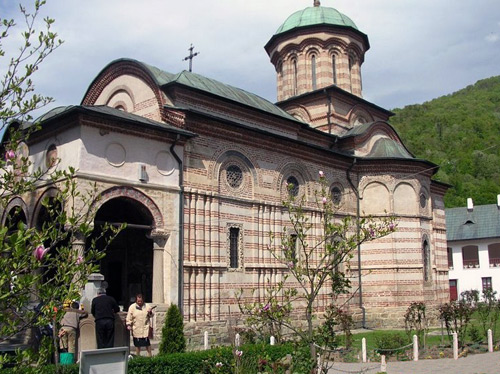
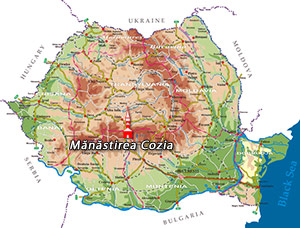
Known as the oldest and most complex historical and art monuments from Romania, Cozia Monastery is situated on the right bank of the river Olt, 22 km away from Ramnicu Valcea and 75 km away from Sibiu. It was built between 1386-1388, being one of the most important foundations of the ruler Mircea cel Batran (Mircea the Ancient). Initially, it was known under the name of Nucet Monastery, because it was built in an area proper for walnut trees to grow. The name of “Cozia” was given to it later, after the name of the mountain in its vicinity.
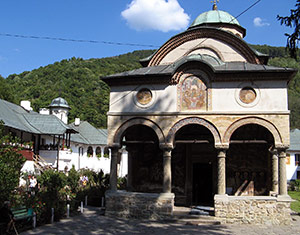
In the Great Church, namely in the nave, that has “The Holy Trinity” as its celebration day, one can see the original paintings. There, on the Western wall, there are paintings that present Mircea and his son Mihail wearing knight outfits and on the left, one can see the portrait of Serban Cantacuzino. In the pronaos you can see the tombs of Mircea and of the nun Teofana, Michael the Brave’s mother, who became a nun after her son’s death. She eventually died in 1605.
There are barely any genuine traces from Mircea the Ancient’s time left at Cozia Monastery. The only items left from the time of the ruler – two bells – were taken one to the Bishopric of Ramnic and the other to the Bishopric of Arges. Mirceal cel Batran (Mircea the Ancient’s) epitaph was taken as well to the Art Museum in Bucharest and only a small piece of the ruler’s tomb remained at the Cozia Monastery. Further more, the cross pattern that even today stands on the monastery tower dates from Mircea the Ancient’s time.
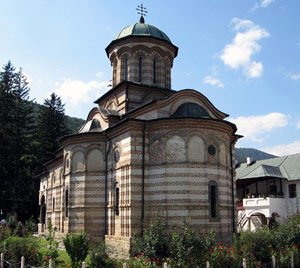
Ceausescu’s stained glass windows, demolished
On the other hand, Ceausescu managed to leave something behind at Cozia Monastery, even if he visited it only once in his life time, not long after he became president. Nicolae and Elena Ceausescu’s portraits remained for some years in the museum of the monastery, together with the ones of the great rulers that have brought their contribution at the consolidation of the fortress. But before the Revolution, the stained glass windows representing Ceausescu and his wife were demolished and hidden in the attic of the monastery.
The stained glass windows were brought there in 1986 from the District Museum. Ceausescu’s portrait could be seen together with the ones representing Decebal, Burebista, Petru Voievod, Mircea Voievod. Before the Revolution, the Bishop of Arges came at the monastery with a delegation of English Lords and demanded that the portraits should be taken down. No one knew where they knew that a revolution was about to burst.
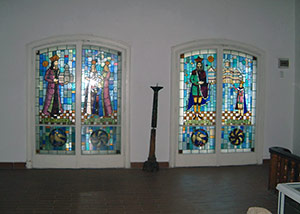
Ceausescu even wrote his impression in the Golden Book of the monastery, on the first page on 11th June of 1966: “I’ve visited with great interest Cozia Monastery, one of the most representative monuments of our ancient art, the sanctuary where Mircea cel Batran (Mircea the Ancient), the great Ruler of Walachia, lays to rest. Mircea and all the other rulers’ battles for freedom and integrity have accomplished today their goals in our free and independent country-The Socialist Republic Romania.”
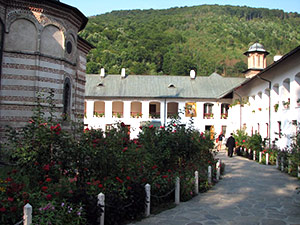
The monastery has two chapels, one of them dating from 1583 and having “The Assumption of the Virgin” as the celebration day and the other one, which is situated in the North-Western side and built of bricks. The latter includes two vaulted houses and a tower that date from 1710-1711. The infirmary is situated on the other side of the road, with “The Holy Apostles” as its celebration day. It was built between 1542-1543 during Petre Voievod’s reign. On the Eastern side of this building is there a museum where coins, old printings, cult items and ornaments are exposed.
The old Cozia (“the stony hermitage-this is the name the ruins of a former church, whose walls could be seen until 1986 on the valley of the river Olt) is situated 1km away from the monastery, having “John, the Baptist” as its celebration day. It is believed that it would be Radu’s foundation, built at the end of the 13th century and at the beginning of the 14th century.( Radu is Mircea’s father).
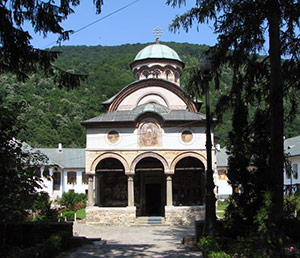
The monument keeps the mark of the greatest rulers of Wallachia: the inner paintings, done initially between 1390-1391 were redone after 1512 by Neagoe Basarab, who built the well that bears his name even today. After 1706, Constantin Brancoveanu built the church porch in the style called “brancovenian style”. The rest of the church is built in Byzantine style with local influences. The mural paintings from Cozia Monastery are actually goods of the National Cultural Patrimony.
Cozia is the most visited monastery from Romania, because of the fact that the museum of the monastery is the only one for which no taxes are required.
How to get there?
The access to Cozia Monastery can be made following the road A1/E81 till Pitesti (115 km) and following the road E81 to Ramnicu Valcea (68 km), Calimanesti (14 km) and Caciulata (3km), the total distance being of 200 km.
Contact:
Address: Calinesti-Caciulata, Valcea County
Phone: +40 (250) 750230
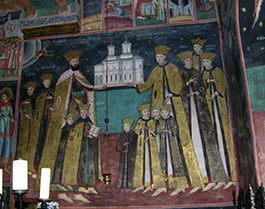
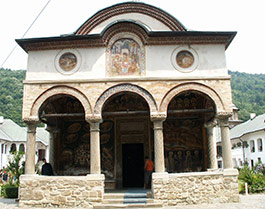
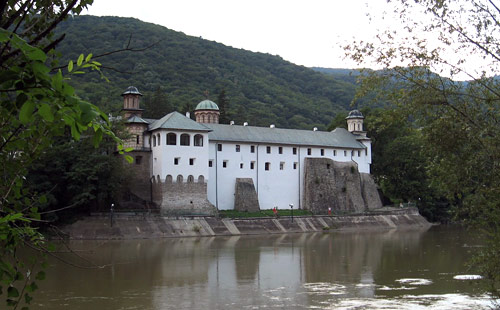
 Travel Bucovina
Travel Bucovina Travel Maramures
Travel Maramures Travel Romania
Travel Romania Other Monasteries from Romania
Other Monasteries from Romania

